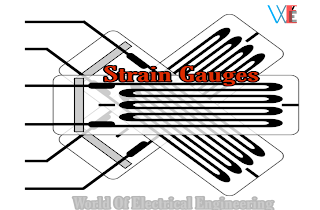Strain Gauge | Different Types of strain Gauge | Electrical Measurement Theory
 |
| Strain Gauge | Different Types of strain Gauge | Electrical Measurement Theory |
There are mainly two types of strain Gauge:
- Semiconductor Strain Gauge
- Capacitive Strain Gauge
These two types of strain gauges are described below in detail:
Semi-conductor Strain Gauges
Semi-conductor strain gauges depend for their action upon piezo-resistive effect, such that the
change in value of the resistance due to change in resistivity.
change in value of the resistance due to change in resistivity.
These gauges are used where a uery high gauge factor and small enuelope are required.
For semi-conductor strain gauges semiconducting materials such as silicon and germanium are used.
A typical strain gauge consists of a strain sensitive crystal material and leads that are
sandwiched in a protective matrix.
sandwiched in a protective matrix.
The production of these gauges employs conventional semi-conductor technology using semi-conducting wafers or filaments which have a thickness of 0.05 mm and bonding them on suitable insulating substances, such as teflon.
Gold leads are generally applied for making the contacts.
semi-conductor strain gauge are shown in below image:
 |
| Semiconductor Strain Gauge | Types of Strain Gauge |
Capacitive Strain Gauges
It uses the principle of variation of capacitance
with variation of distance between electrodes.
with variation of distance between electrodes.
The electrodes are flexible metal strips of about 0.1 mm thickness.
The figure of capacitive type strain gauge is shown in below figure:
 |
| Capacitive Strain Gauge | Types of strain Gauge |
The strain to be measured is applied to the
top plate.
top plate.
This changes the distance between the
curved electrodes resulting in change of capacitance.
curved electrodes resulting in change of capacitance.
The strain-capacitance relationship, in general, is not linear but variations in dimensions and shape allow gauge characteristics to be chosen so as to match the range of capacitance to be measured with a good degree of accuracy.
A capacitance strain gauge has a capacitance of about 0.5 pF.
✓Its overall size is 5 mm x 17 mm x 1 mm.
✓It uses a polyamide film of insulating material.
✓It can be used upto a temperature of 300C.

Comments
Post a Comment